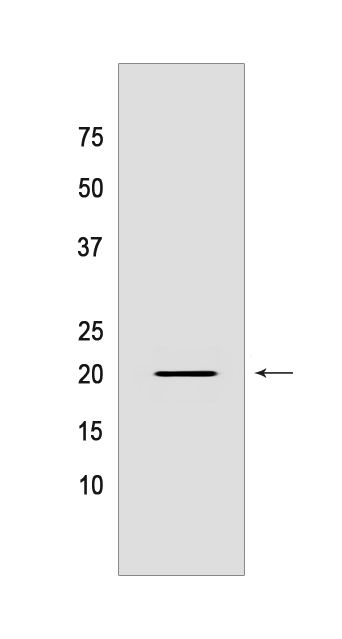COMMD1 Mouse mAb[Q2TN]Cat NO.: A98083
Western blot(SDS PAGE) analysis of extracts from HT-29 cells.Using COMMD1 Mouse mAb IgG [Q2TN] at dilution of 1:1000 incubated at 4℃ over night.
Product information
Protein names :COMMD1,C2orf5,MURR1,COMD1_HUMAN,COMM domain-containing protein 1
UniProtID :Q8N668
MASS(da) :21,178
MW(kDa) :20kDa
Form :Liquid
Purification :Protein A purification
Host :Mouse
Isotype :IgG
sensitivity :Endogenous
Reactivity :Human,Mouse,Rat
- ApplicationDilution
- 免疫印迹(WB)1:1000-2000
- 免疫组化(IHC)1:100
- 免疫荧光(ICC/IF) 1:100,
- The optimal dilutions should be determined by the end user
Specificity :Antibody is produced by immunizing animals with a synthetic peptide of human COMMD1.
Storage :Antibody store in 10 mM PBS, 0.5mg/ml BSA, 50% glycerol. Shipped at 4°C. Store at-20°C or -80°C. Products are valid for one natural year of receipt.Avoid repeated freeze / thaw cycles.
WB Positive detected :HT-29 cells
Function : Proposed scaffold protein that is implicated in diverse physiological processes and whose function may be in part linked to its ability to regulate ubiquitination of specific cellular proteins. Can modulate activity of cullin-RING E3 ubiquitin ligase (CRL) complexes by displacing CAND1,in vitro promotes CRL E3 activity and dissociates CAND1 from CUL1 and CUL2 (PubMed:21778237). Promotes ubiquitination of NF-kappa-B subunit RELA and its subsequent proteasomal degradation. Down-regulates NF-kappa-B activity (PubMed:15799966, PubMed:17183367, PubMed:20048074). Involved in the regulation of membrane expression and ubiquitination of SLC12A2 (PubMed:23515529). Modulates Na(+) transport in epithelial cells by regulation of apical cell surface expression of amiloride-sensitive sodium channel (ENaC) subunits and by promoting their ubiquitination presumably involving NEDD4L. Promotes the localization of SCNN1D to recycling endosomes (PubMed:14645214, PubMed:20237237, PubMed:21741370). Promotes CFTR cell surface expression through regulation of its ubiquitination (PubMed:21483833). Down-regulates SOD1 activity by interfering with its homodimerization (PubMed:20595380). Plays a role in copper ion homeostasis. Involved in copper-dependent ATP7A trafficking between the trans-Golgi network and vesicles in the cell periphery,the function is proposed to depend on its association within the CCC complex and cooperation with the WASH complex on early endosomes (PubMed:25355947). Can bind one copper ion per monomer (PubMed:17309234). May function to facilitate biliary copper excretion within hepatocytes. Binds to phosphatidylinositol 4,5-bisphosphate (PtdIns(4,5)P2) (PubMed:18940794). Involved in the regulation of HIF1A-mediated transcription,competes with ARNT/Hif-1-beta for binding to HIF1A resulting in decreased DNA binding and impaired transcriptional activation by HIF-1 (PubMed:20458141). Negatively regulates neuroblastoma G1/S phase cell cycle progression and cell proliferation by stimulating ubiquitination of NF-kappa-B subunit RELA and NF-kappa-B degradation in a FAM107A- and actin-dependent manner (PubMed:28604741)..
Tissue specificity :Ubiquitous. Highest expression in the liver, with lower expression in brain, lung, placenta, pancreas, small intestine, heart, skeletal muscle, kidney and placenta. Down-regulated in cancer tissues..
Subcellular locationi :Nucleus. Cytoplasm. Endosome membrane. Cytoplasmic vesicle. Early endosome. Recycling endosome.
IMPORTANT: For western blots, incubate membrane with diluted primary antibody in 1% w/v BSA, 1X TBST at 4°C overnight.


